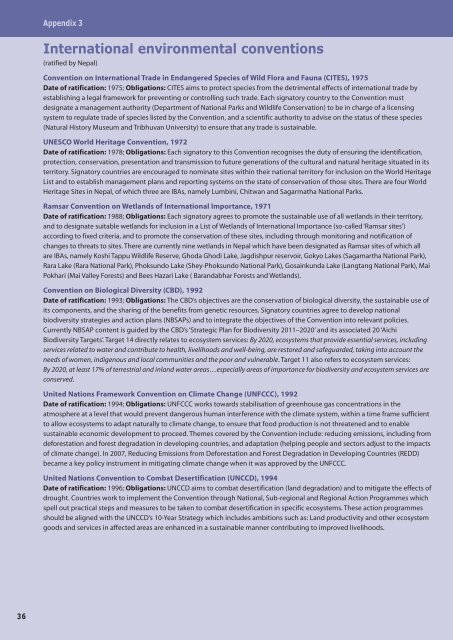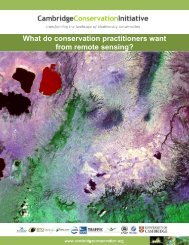CONSERVING BIODIVERSITY & DELIVERING ECOSYSTEM SERVICES
conserving biodiversity & delivering ecosystem services
conserving biodiversity & delivering ecosystem services
Create successful ePaper yourself
Turn your PDF publications into a flip-book with our unique Google optimized e-Paper software.
(ratified by Nepal)<br />
Convention on International Trade in Endangered Species of Wild Flora and Fauna (CITES), 1975<br />
Date of ratification: 1975; Obligations: CITES aims to protect species from the detrimental effects of international trade by<br />
establishing a legal framework for preventing or controlling such trade. Each signatory country to the Convention must<br />
designate a management authority (Department of National Parks and Wildlife Conservation) to be in charge of a licensing<br />
system to regulate trade of species listed by the Convention, and a scientific authority to advise on the status of these species<br />
(Natural History Museum and Tribhuvan University) to ensure that any trade is sustainable.<br />
UNESCO World Heritage Convention, 1972<br />
Date of ratification: 1978; Obligations: Each signatory to this Convention recognises the duty of ensuring the identification,<br />
protection, conservation, presentation and transmission to future generations of the cultural and natural heritage situated in its<br />
territory. Signatory countries are encouraged to nominate sites within their national territory for inclusion on the World Heritage<br />
List and to establish management plans and reporting systems on the state of conservation of those sites. There are four World<br />
Heritage Sites in Nepal, of which three are IBAs, namely Lumbini, Chitwan and Sagarmatha National Parks.<br />
Ramsar Convention on Wetlands of International Importance, 1971<br />
Date of ratification: 1988; Obligations: Each signatory agrees to promote the sustainable use of all wetlands in their territory,<br />
and to designate suitable wetlands for inclusion in a List of Wetlands of International Importance (so-called ‘Ramsar sites’)<br />
according to fixed criteria, and to promote the conservation of these sites, including through monitoring and notification of<br />
changes to threats to sites. There are currently nine wetlands in Nepal which have been designated as Ramsar sites of which all<br />
are IBAs, namely Koshi Tappu Wildlife Reserve, Ghoda Ghodi Lake, Jagdishpur reservoir, Gokyo Lakes (Sagamartha National Park),<br />
Rara Lake (Rara National Park), Phoksundo Lake (Shey-Phoksundo National Park), Gosainkunda Lake (Langtang National Park), Mai<br />
Pokhari (Mai Valley Forests) and Bees Hazari Lake ( Barandabhar Forests and Wetlands).<br />
Convention on Biological Diversity (CBD), 1992<br />
Date of ratification: 1993; Obligations: The CBD’s objectives are the conservation of biological diversity, the sustainable use of<br />
its components, and the sharing of the benefits from genetic resources. Signatory countries agree to develop national<br />
biodiversity strategies and action plans (NBSAPs) and to integrate the objectives of the Convention into relevant policies.<br />
Currently NBSAP content is guided by the CBD’s ‘Strategic Plan for Biodiversity 2011–2020’ and its associated 20 ‘Aichi<br />
Biodiversity Targets’. Target 14 directly relates to ecosystem services: By 2020, ecosystems that provide essential services, including<br />
services related to water and contribute to health, livelihoods and well-being, are restored and safeguarded, taking into account the<br />
needs of women, indigenous and local communities and the poor and vulnerable. Target 11 also refers to ecosystem services:<br />
By 2020, at least 17% of terrestrial and inland water areas…especially areas of importance for biodiversity and ecosystem services are<br />
conserved.<br />
United Nations Framework Convention on Climate Change (UNFCCC), 1992<br />
Date of ratification: 1994; Obligations: UNFCCC works towards stabilisation of greenhouse gas concentrations in the<br />
atmosphere at a level that would prevent dangerous human interference with the climate system, within a time frame sufficient<br />
to allow ecosystems to adapt naturally to climate change, to ensure that food production is not threatened and to enable<br />
sustainable economic development to proceed. Themes covered by the Convention include: reducing emissions, including from<br />
deforestation and forest degradation in developing countries, and adaptation (helping people and sectors adjust to the impacts<br />
of climate change). In 2007, Reducing Emissions from Deforestation and Forest Degradation in Developing Countries (REDD)<br />
became a key policy instrument in mitigating climate change when it was approved by the UNFCCC.<br />
United Nations Convention to Combat Desertification (UNCCD), 1994<br />
Date of ratification: 1996; Obligations: UNCCD aims to combat desertification (land degradation) and to mitigate the effects of<br />
drought. Countries work to implement the Convention through National, Sub-regional and Regional Action Programmes which<br />
spell out practical steps and measures to be taken to combat desertification in specific ecosystems. These action programmes<br />
should be aligned with the UNCCD’s 10-Year Strategy which includes ambitions such as: Land productivity and other ecosystem<br />
goods and services in affected areas are enhanced in a sustainable manner contributing to improved livelihoods.




